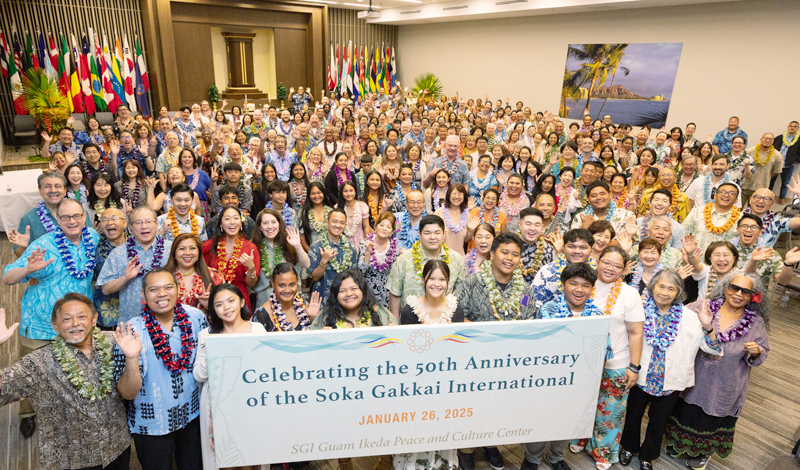TAMUNING, Guam—With hearts as vast and embracing as the Pacific Ocean, the members of SGI-USA Guam welcomed representatives from throughout the Mariana Islands and the U.S. for the Soka Gakkai International 50th Anniversary Commemorative Meeting, held on Jan. 26, 2025, at the Guam Ikeda Peace and Culture Center.
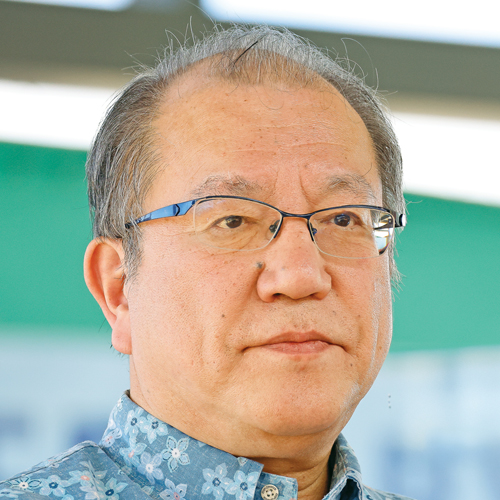
The meeting, led by the newly appointed SGI General Director Yoshiki Tanigawa, represented a launching point for the next 50 years of global kosen-rufu. SGI Vice General Director Shinji Shimizu and SGI Young Men’s Leader Hideaki Yanashima were also in attendance.
In a message to the event, Soka Gakkai President Minoru Harada thanked everyone for their dedicated efforts, which made celebrating this significant milestone possible with fellow members around the world.
He recalled how in 1974, the year before the SGI was established, Ikeda Sensei spent 102 days abroad, conducting groundbreaking peace-diplomacy efforts, particularly in China and the Soviet Union amid the escalating tensions of the Cold War. In January 1975, he amplified these efforts by visiting the United Nations in New York, followed by four other major cities before departing to Guam.
(While in New York, Sensei presented 11 million signatures to U.N. officials, calling for the abolition of nuclear weapons and the eradication of war. In Washington, D.C., he met at the U.S. State Department with then-Secretary of State Henry Kissinger to discuss pathways to peace and laid a wreath at the Tomb of the Unknown Solider at the Arlington National Cemetery. He also donated 10,000 books to the Library of Congress and 1,000 to the University of Chicago.)
President Harada said that, at one point, he couldn’t help but voice how moved he was to observe Sensei’s bold and dynamic efforts, the way he poured every ounce of energy into advancing kosen-rufu.
Sensei replied that he was striving solely for the sake of his mentor, Josei Toda, and the members: “How much strength does a human being possess? When a person upholds a correct view of life, how mighty can they truly be? This is what I’m trying to establish.”
President Harada said that for disciples to fulfill their debt of gratitude to their mentor, they embrace the mission to create an everlasting flow of kosen-rufu, ensuring the perpetuation of the Mystic Law. Such a determination, based on gratitude, enables us to draw out infinite strength.
“Now is precisely the time for each of us to respond to Sensei’s expectations,” he said. “Let us earnestly chant daimoku based on the shared vow of mentor and disciple and continue ‘sowing the seeds of peace of the Mystic Law’ in each of our districts and chapters, our local communities and society as a whole.”
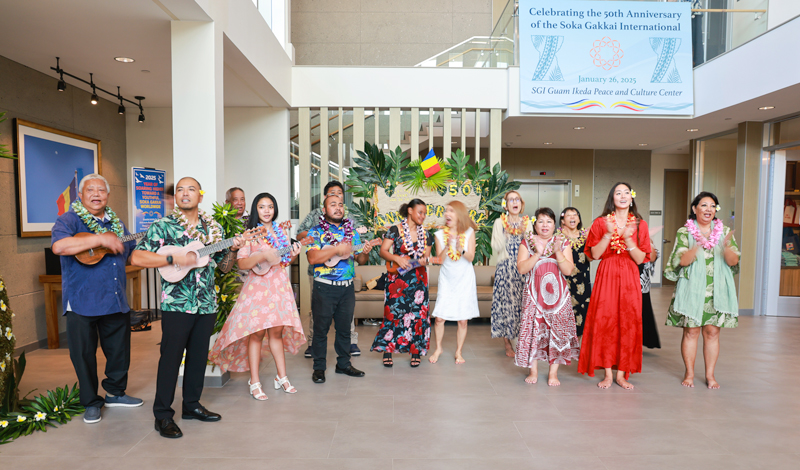
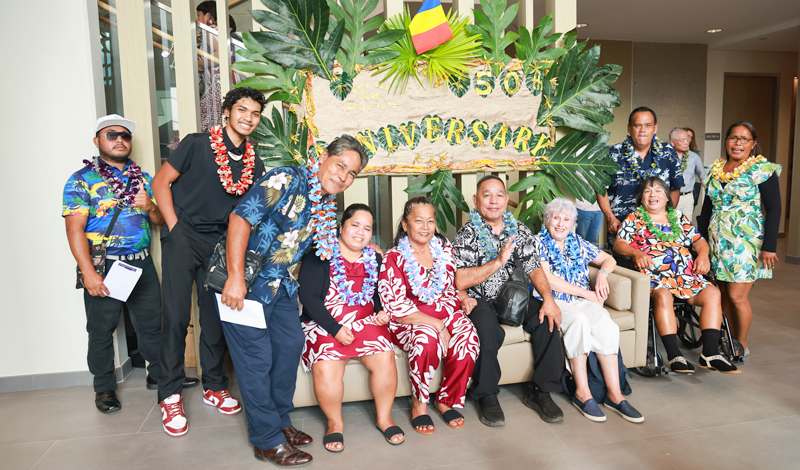
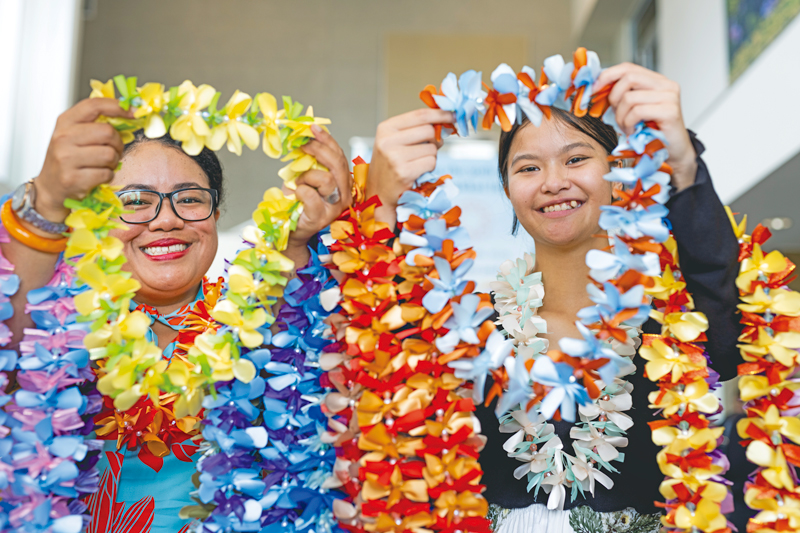
‘Kosen-rufu equals world peace.’
The meeting was held at the state-of-the-art Guam center, opened in January 2023, and located just a stone’s throw from the International Trade Center Building, where, on Jan. 26, 1975, representatives from 51 countries and territories established the Soka Gakkai International, electing Daisaku Ikeda its president.
The founding members, having bore witness to the horrors of war in the 20th century, vowed to make the forthcoming era a “Century of Life.” Symbolizing this resolve, Sensei designated “The World” as his nationality in the event guest book. Recalling these humble origins, Sensei wrote in January 2000:
It was a gathering on an island that is a jewel of the Pacific. There were no presidents, no ministers of state or political leaders, no tycoons, no scholars there that day. There were no reporters from the television stations or the newspapers covering it. Who was there? Ordinary citizens representing ordinary citizens. But these ordinary men and women were actually great pioneers who had pledged to dedicate their lives to the mission of propagating Nichiren Buddhism and bringing peace to the world.[1]
Fifty years later, participants were welcomed into the Guam center’s two-story atrium lobby as local members placed hand-crafted fabric leis around their necks and dancers performed gracefully to “Pearly Shells” and other island folk songs, accompanied by the ukulele.
During the 50th-anniversary meeting, Hideaki Yanashima, the SGI young men’s leader, underscored the mission that SGI members embody to bring peace to the world by relaying his discussion on New Year’s Day with a U.N. official who assists refugees in the Middle East. “His daily life is as harsh as witnessing the very bus he was on or the restaurant he was just eating at being blown up by a bomb,” Mr. Yanashima said.
Amid such challenges, this U.N. official is also a leader in SGI Jerusalem District, where both Israelis and Palestinians come together to chant Nam-myoho-renge-kyo for one another’s happiness and for peace. At their December discussion meeting, the members explained to a guest how a lotus flower blossoms in muddy waters, and how these flowers are connected at the root, just like human beings. The SGI, they said, “is truly an oasis in the mud” of the ongoing war.
Mr. Yanashima said that while many people have lost hope that a resolution will be found, “Sensei said that ‘peace is always a competition between resignation and hope.’[2] The solidarity that the SGI is spreading throughout the world is a fortress of peace and hope. I feel this is what it means when we say: ‘Kosen-rufu equals world peace.’”
The SGI spirit lives on in our efforts to treasure each person.
Participants were treated to a moving video on the SGI’s founding, featuring interviews from the Guam members on the significance of having the SGI established on their island. Sensei wrote in The New Human Revolution that he had chosen Guam as the stage for the SGI’s establishment with a resolve “to somehow make Guam, a place that had suffered so terribly from the ravages of war, into a beacon for global peace.”[3]
Last November, to mark the one-year anniversary of Sensei’s passing, the Soka Gakkai Constitution was revised to underscore his achievements in globalizing Nichiren Buddhism, thus regarding him as the “mentor of worldwide kosen-rufu and the President and spiritual leader of the Soka Gakkai International in perpetuity.”
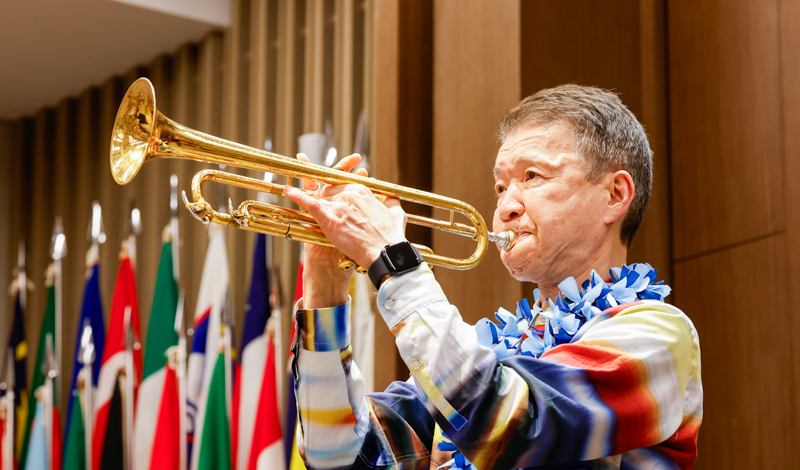
In a deeply poignant moment, the Grammy Award-winning artist Shunzo Ohno took to the stage to perform his rendition of “Somewhere Over the Rainbow.” Members know well his comeback story: recovering from what should have been a career-ending car accident only to face stage 4 throat cancer. Basing himself on Sensei’s guidance to “rise up again like a phoenix,”[4] he overcame all to return to health and center stage.
Under his leadership, the SGI grew into a broad-ranging Buddhist movement centered on peace, culture and education. With more than 12 million Buddhist practitioners in 192 countries and territories, the SGI is the largest and most diverse lay Buddhist movement in the world.
Amelia Gonzalez Tesch, the SGI-USA young women’s leader declared that the spirit of the members who gathered in 1975, pledging to make their mentor’s vow their own, lives on today in the SGI.
As youth, they are taking the initiative to reach out to their friends, family and neighbors to create bonds of trust by treasuring each relationship, no matter their background or beliefs.
“There is no separation from those who gathered 50 years ago, pledging to achieve kosen-rufu in their respective countries as disciples of Sensei, and those of us gathered here today, striving to do the same,” she said, sharing the youth determination to gather 15,000 young people at district discussion meetings in March in solidarity of peace. “Thank you so much, Sensei, we will do it!”
‘We won! We did it!’
The Guam event had been two years in the making. Several months after the Guam center opened in January 2023, SGI-USA Executive Advisor Danny Nagashima moved to the island to support the region’s growth and preparations toward the 50th-anniversary event.
The Marianas Region team had just made a series of bold goals toward the milestone anniversary—which included launching a massive grassroots effort to share Buddhism on the island—when, on May 24, 2023, Typhoon Mawar brought hurricane-force winds and heavy rainfall to Guam, destroying homes and knocking out power across the island.
The region team mobilized quickly to visit each member, providing them with relief supplies and faith encouragement. As the island began its recovery efforts, every Saturday at 5 a.m., members arrived at the local flea market to share Nam-myoho-renge-kyo cards with the locals. Within two years, they surpassed their goal, planting more than 36,600 seeds of the Mystic Law, which represents roughly 21% of the island’s population.
For more than a year toward the event, Many Treasures Group representatives gathered weekly to chant daimoku and then fashion beautiful fabric leis by hand.
John Tedtaotao, a CHamoru native, crafted latte stones to grace the entrance to the main auditorium and stage. The stone monoliths, originally carved by ancient CHamorus from coral limestone to serve as the foundation for their homes, today represent the identity, strength and resilience of the native people.
The week of the event, he and other members went into the jungle to gather traditional moss and leaves to cover the latte stones. On the morning of the event, the latte stones were dotted with freshly cut plumeria flowers.
Mr. Nagashima addressed the members at the meeting, leading them spontaneously in the chorus of the famous “Hafa Adai” song and then saying: “We won! We did it! Congratulations!”
Illuminating the world with the flame of the Mystic Law.
Yoshiki Tanigawa, who was appointed as the SGI General Director in November 2024, said that the meeting represented a significant occasion in which SGI leaders from the United States, the center of worldwide kosen-rufu in the 21st century, were making a fresh departure with the spirit “Now, more than ever,” in a moment that arguably could determine the fate of humankind.
He then relayed an episode from volume 18 of The New Human Revolution in which second Soka Gakkai President Josei Toda entrusts the young Daisaku with the mission of worldwide propagation, saying in part:
Across the sea lies a vast continent. It’s a big, wide world. [In many countries,] people still weep in anguish and children cower in the crossfire of war. You must illuminate Asia and the entire world with the flame of the Mystic Law. You must do this in my place.[5]
Six years from that day, in October 1960, Sensei set out on his maiden voyage to spread Nichiren Buddhism around the world, considering deeply the various problems he was likely to face overseas, such as how to deal with the differences in custom and tradition that existed between Japan and other areas of the world.
In volume 1 of The New Human Revolution, Sensei addresses a leader accompanying him who asks what they should wear to the local discussion meeting. He replies:
There is a concept in Buddhism known as zuiho bini[6]—meaning that so long as one does not deviate from the essential teachings of Nichiren Buddhism, that is, faith in the Gohonzon, it is fine to make the formalities of Buddhism conform with the manners and customs of each area and with the conventions of the times.[7]
Mr. Tanigawa then asked: Now that the era has shifted from the earliest pioneers to those who are third- and fourth-generation SGI members, how do we stay true to the essential and unchanging spirit of the Soka Gakkai while meeting the demands of a rapidly changing time in society? How do we accelerate the kosen-rufu movement from here?
“I believe that on this 50th anniversary of the SGI, we have been tasked with the mission and responsibility to develop a new ‘zuiho bini,’ an adaptable approach, accessible to people of today,” he said. “I’m confident that this new current will also begin from America, the center of global kosen-rufu in the 21st century, from this very gathering here in Guam.”
Jade Chen, a young women’s leader from Chino Hills, California, said the weekend’s events instilled in her a sense of conviction that there is hope for peace, for a world without war. And speaking of the Guam members, she said: “This is the warmest center I’ve ever walked into. You can feel each person’s heart. I want to bring that home.”
Sensei’s words from the 1975 meeting, emblazoned on a plaque adorning the center’s entrance, seemed to ring ever more deeply in the participants hearts as they set off toward the next 50 years:
Rather than seeking after your own praise or glory, I hope that you will dedicate your noble lives to sowing the seeds of peace of the Mystic Law throughout the entire world. I shall do the same.[8]
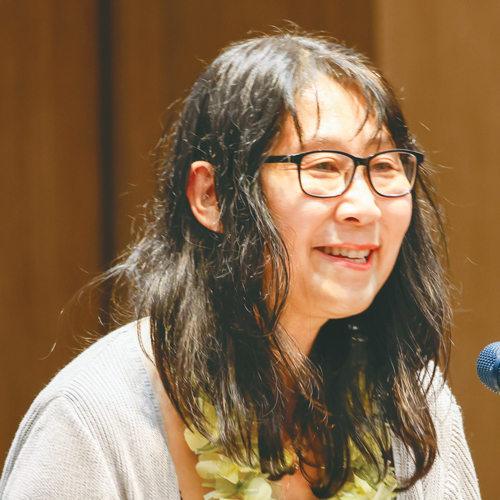
“We have come together today to embark on a grand new history for SGI-USA toward the next 50 years as the center and model of worldwide kosen-rufu.”
—Naoko Leslie, SGI-USA Women’s Leader
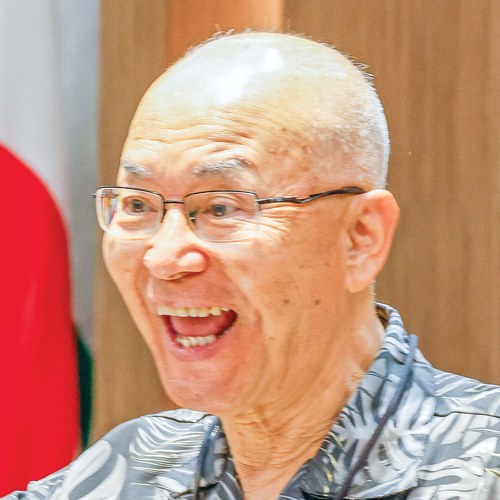
“We won! We did it!”
—Danny Nagashima, SGI-USA Executive Advisor
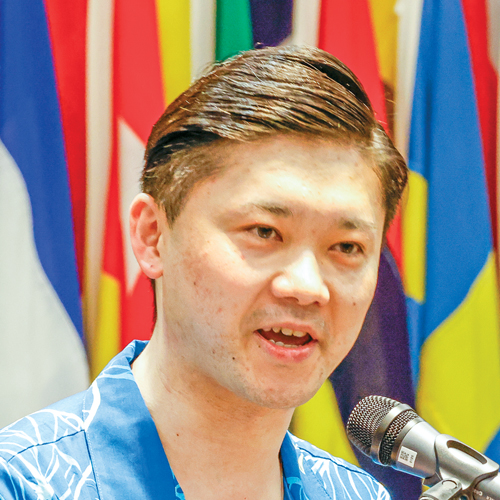
“The solidarity that the SGI is spreading throughout the world is a fortress of peace and hope.”
—Hideaki Yanashima, SGI Young Men’s Leader
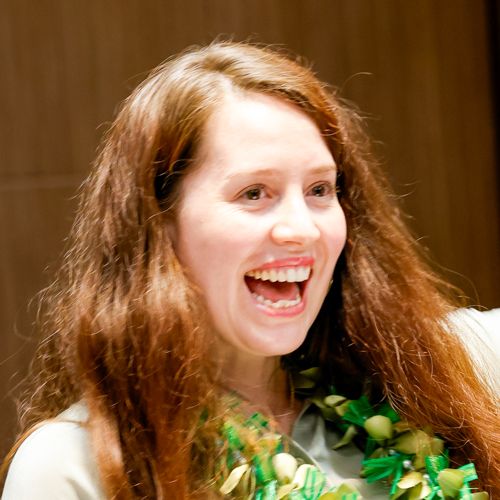
“There is no separation from those who gathered 50 years ago, pledging to achieve kosen-rufu in their respective countries as disciples of Sensei, and those of us gathered here today, striving to do the same.”
—Amelia Gonzalez Tesch, SGI-USA Young Women’s Leader
February 14, 2025, World Tribune, pp. 6–9
You are reading {{ meterCount }} of {{ meterMax }} free premium articles

